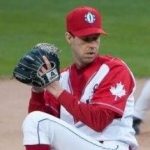The best moment of my life as a pitcher was getting drafted by a Major League Baseball team. I was hanging by the phone all day when the scouting director for the Toronto Blue Jays called my parents’ home. As soon as somebody asked for me in a grown-up voice, I knew. My heart rate went through the roof. I went outside and ran.
The worst moment was when I got hurt. I was pitching the season opener for a university team when I fielded a dribbler and threw awkwardly to first base. My back popped. I would never be the same again. It was demoralizing to think I’d peaked at age 21.
I grew up in a village of 500 called Keene, near Peterborough, Ont. My father Frank ran a small-town law firm. My mother Anne was his legal secretary. Dad was also my baseball coach for all the years I played house league.
At 18 I was a low-level Major League prospect. Those years were stressful but exciting. Scouts and U.S. college coaches were recruiting. They go to your tournaments, talk to you, send Christmas cards. You know they’re watching.
The Blue Jays drafted me the first time in 1994. They sent me to play on a team in Surrey, B.C., the National Baseball Institute, a feeder program to the national team. It was an intense and professional environment. I was away from home for the first time in my life at Simon Fraser University with a full load of courses, training at the ball park every day, with road trips to Idaho and California and everywhere in between.
Some kids couldn’t cope and went home after a couple of months. I loved it. I’m still best friends with my first-year roommate. At the end of that year I wasn’t called up, so I went to Winthrop University in South Carolina on full scholarship. That was where I got hurt.
I’ve played ball in Italy, Nicaragua, Panama, Spain, the Netherlands and Austria. My wife and I moved to Ottawa to raise our kids, but baseball was still not out of my system. I played for the Ottawa Fat Cats in their 2010 debut year. To this day my back still aches.
The greatest success of my career came after I got hurt. I try now to adapt this lesson in coaching kids. It’s not about how to hold the bat or grip the ball. More important is what goes on between the ears. Fear is a big deal for kids, and coaches need to talk about that. I try to draw on some of the things I struggled with as a player, and things I wish people had told me.
It’s absolutely crucial for kids to walk away from the ball park feeling like they are successful and they are progressing. Until we go to the grave, we could all use some coaching.
(Editor’s note: the author is two-time Blue Jays draft pick, now a children’s coach in the oldest chartered Little League in Canada, Ottawa’s Glebe league founded in 1955).






